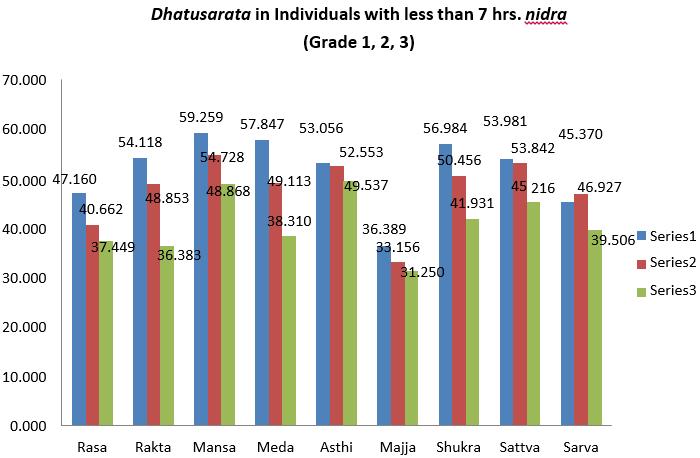1 2
*Dr.ManishaSharma,Dr.IqbalSingh1M.D.Ayu,Professor,DepartmentofRogNidan,G.N.A.M.C.,Gopalpur,Ludhiana(PB.),India.(*CorrespondingAuthor) 2P.G.Scholar,S.G.M.(P.G.)Ayu.MedicalCollege&Hospital,Saheri,Ghazipur(U.P.),India.

1 2
*Dr.ManishaSharma,Dr.IqbalSingh1M.D.Ayu,Professor,DepartmentofRogNidan,G.N.A.M.C.,Gopalpur,Ludhiana(PB.),India.(*CorrespondingAuthor) 2P.G.Scholar,S.G.M.(P.G.)Ayu.MedicalCollege&Hospital,Saheri,Ghazipur(U.P.),India.
Acharya Charaka hasdesignated ahara (food), nidra (sleep)and brahmacharya (abstinence)asthemainthreepillarsoflifetermedas trayaupastambhas These, whentakeninadequateamountattherighttimeprovidestabilitytothebodyandimprovebala(stremgth),varna(complexion)andupchaya(metabolism)inthebody Amongthese, nidra playsamajorroleinone'slife.Adequatesleepleadsto arogya (health), bala shukra vridhi (increaseinphysicalandreproductivestrength)and dhatusamyata andhealthylifewhichistheultimategoalofAyurveda.Ontheotherhand,alteredsleepleadsto bala hani (lossofstrength), rugnavastha (diseased state)orevendeath.Soitcanbesaidthatabnormalorinadequatenidracanmanifestintheformofdhatuvikara,makingapersonatura(diseased).Forbettereconomic gains,peopleareneglectingtheirdailyneedsofhavingproper ahara, nidra andotherrequired vihara atpropertime.Duetothesereasons,peoplearebecomingmore prone towards diseased state. Dashavidha-atura pariksha, given by Acharya Charak is very unique and important concept ofAyurveda which is done to know pramana (magnitude)of ayu (life), dosha and bala (strength)of rogi Dhatusara pariksha isoneamongthesewhichliterallymeansessenceof dhatu,possessingall goodqualitiesinexcellentstandardwithoutanydefects.Thepresentstudywasdonetostudytherelationshipof nidra on dhatusarata,withthepurposethatpeople shouldunderstandtheimportanceofnidraasonlyahealthyindividualcanleadtotheformationofahealthysociety
KEYWORDS:Nidra,Trayaupastambhas.
Ayurvedahasmentionedtheaimsas,tomaintainthehealthystatusofahuman 1 beingandsecondlytocurethediseasedones.VariousconceptshavebeenmentionedinAyurvedicClassicstokeeponeselfhealthywhichareintheformofvarious preventive measures like Yoga, Achara Rasayana (well conducted behavior), Dinacharya (daily regimen), Rutucharya (seasonal regimen) etc. One among them is Traupastambha i e ahara (food), nidra (sleep) and brahmacharya (abstinence),whichwhentakeninadequateamountattheaccuratetimeprovidestabilitytothebodyandimprove bala (stength), varna (com2 plexion)andupchaya(metabolism)inthebody whichdirectlyleadstoswasthya (health)andthatistheultimategoalofAyurveda.Sidewise,causeklaibyata(impotence) bala hani (lossofstrength), aturavastha (diseasedstate)orevendeath iftakeninadequately
3 Dashavidha-aturapariksha isalsoconsideredasveryuniqueandimportantconcept of Ayurveda which has been mentioned by Acharya Charak in Charak vimanasthana Chapter8.Thepurposeof rogi pariksha (patientexamination)is toknowthe pramana (quantity)of ayu (age), dosha and bala (strength)of rogi whichisverymuchessentialfortheselectionofdrug,doseadjustmentandplan oftreatment.Dashavidha-aturaparikshaincludes:
1) Prakriti pariksha (Examination of basic physical and psychological component)
2) Vikritipariksha(Examinationofmorbidchangesinthebody)
3) Sarapariksha(Statusofelementaltissuesandmind)
4) Samhananpariksha(Compactnessofthebody) 5) Satvapariksha(mentalstrength) 6) Satmyapariksha(compatibilities) 7) Pramanapariksha(measurementofbodyorbodyparts)
8) Aharashakti(metabolismanddigestioncapacity) 9) Vyayamashakti(Exercisetoleranceofthepatient)
10) Vaya(age)
Among all these, sara pariksha plays an important role to know the bala 4 pramana (magnitude of physical strength) of the patient Sara literally means essenceof dhatu,possessingallgoodqualitiesinexcellentstandardwithoutany defects.The dhatus whichhassuchanexcellencewillhavethecapacitytoresist diseasesanddoallitsnormalfunctionsefficiently Onthebasisof sarata,aphysiciancandetermineaswellasdiagnosethe bala ofthe rogi whichwillhelphim intreatingthediseaseinabetterway Patientsaretobeexaminedwithreference to sara or the excellence of their dhatus With a view to determine the specific 5 measure of bala, they are classified into eight categories, depending upon the saraorexcellenceoftheirdhatus
Ÿ
Tvaksara
Raktasara
Mamsasara
Medasara
Asthisara
Majjasara
Shukrasara
Satvasara
Thepersonendowedwithallthesaraissuretoearngreatrespect,hopefulofsuccessinallhisactivities,capableofwithstandingtroubles,willbewiseandready
Intoday'seraofindustrialization,advancedtechniquesandresearchmethodsare appliedforbettereconomicgains.Duetothiscompetitioneveryoneisstruggling tostayintheracewhichisautomaticallyreducingone'sattentionofmaintaining agoodhealth.Peopleareworkingdayandnightfortheirlivelihoodandneglectingthefactorslike ahara, nidra etc.inproperquantityandqualitywhichhave affectedtheirlifeaswellashealthintheformofvariouslifestyledisordersnowa days.
The present study was done to study the effect of nidra on dhatusarata which helpinunderstandingthechangesthatoccuronthesarataofthepersonwhenhe getsalteredorabnormalnidra.
The study has been aimed to observe the effect of atiyoga (abnormally high), mithyayoga (improper) and heenayoga (abnormally low) of nidra on dhatusarataofwillingvolunteersselectedforthestudy
Typeofstudy:Retrospectivetypeofstudy Clinicalsurvey

Placeofstudy:BharatiVidyapeethUniversityCollegeofAyurvedaandBharati VidyapeethMedicalFoundation'sAyurvedaHospital,Pune-43.
ResearchDesign:Specialcasepaperproformawasprepared.Atotalof127volunteerswerestudiedonthebasisof darshan (inspection) , sparshan (palpation and percussion) and prashna (questioning) pareeksha Written consent was takenfromthevolunteerspriortothestudy
SourceofData:Thedatawascollectedbyexaminationsofvolunteersfromvarious sectors like ITprofessionals, doctors, staff nurses, security guards, drivers (taxiandtruck),students,housewives,etc.withthehelpofaspeciallydesigned questionnaireandcasepaper Itwasfoundthatthenidrapatternsofthesegroups wereremarkablyalteredandhencetheywereincludedinthestudy
Ÿ
InclusionCriteria:
Ÿ
Volunteershavingheena,mithyaandatiyogaofnidraforminimum1year
Ÿ Volunteersirrespectiveofsex,maritalstatusandsocio-economicclass
ExclusionCriteria:
Ÿ Volunteerssufferingfrompriorailmentsofnidra
Ÿ Volunteersbelowage16andabove70years
StatementofLimitation:
This study was done in the rogavigyana (pathology) department and was only associatedwiththediagnosticaspectoftheproblemandhencewasnotdirectly dealtwiththeremedialmeasures.
GradationCriteria:
Thevolunteersincludedinthestudywereclassifiedonthebasisoffollowingfactors: Ÿ Age Ÿ Sex Ÿ
Socio-economicstatus Ÿ Occupation Ÿ Prakruti Ÿ Sarata
Age
Ÿ
Ÿ
Nidra
¨ Quantityofnidra(nidrapramana)
§ Lessthan7hours(heenayoga)
§ Morethan7hours(atiyoga)
¨ Qualityofnidrai.e.khandithanidra(Disturbednidra)
§ Diwasvapna(Daytimenidra)
§ Jagarana(Awakeningatnight)
Initiallythesarataoftheindividualwasanalyzedaccordingtothelakshanas (symptoms)mentionedinthesamhitas Thelakshanashavebeengradedas0 (Aa=Absence), 1 (alpa=Mild), 2 (madhyam=Moderate), 3 (ati=Severe). Lakshanasofeachsara wereaddedseparatelyandthenfromthatscore,percentageofeach sara predominancewascalculated.Inthisway,thepercentageofallthe9saraspresentinall127volunteerswasobtained.
Gradation of volunteers according to the hetus (etiology) like jagarana, diwasvapna,khanditanidra,lessthan7hoursnidra,morethan7hoursnidra wasdone.
Ÿ Volunteers were separated according to the gradation criteria of each hetu relatedtonidra.
Ÿ
Theaverageofpercentageof sarata ineachseparatedgroupof hetus related tonidrahasbeencalculated.
TableNo.1:Classificationofvolunteersonfollowingfactors
No.ofvolunteers(n) Percentage
5-15yrs. 1 0.787 15-25yrs. 30 23.622 25-35yrs. 49 38.583 35-45yrs. 24 18.898 45-55yrs. 14 11.024 55-65yrs. 7 5.512 65-75yrs. 2 1.575 Sex Males 88 69.291 Females 39 30.709
Occupation SecurityGuard 14 11.024 StaffNurse 09 7.087 Drivers 21 16.535 Doctors 07 5.512
ITProfessionals 45 35.433 Students 13 10.236 Housewives 07 5.512
Retired 01 0.787
Others 10 7.874
Prakriti
VataPittaja 22 17.232
VataKaphaja 12 9.449
Pittavataj 25 19.685
Pittakaphaja 24 18.898
Kaphavataj 16 12.598
Kaphapittaja 28 22.047
Socioeconomicstatus
Lower 49 38.583
Middle 65 51.181 Upper 13 10.236
TableNo.2:Classificationofvolunteersonfollowingfactors
Sarata(Acc.TolakshanasmentionedinCharaksamhita)
1(Asara) 07 5.512
2(Twakasara) 14 11.024 3(Raktasara) 20 15.748 4(Mansasara) 34 26.772 5(Medasara) 28 22.047 6(Asthisara) 17 13.386 7(Majjasara) 03 2.362 8(Shukrasara) 03 2.362 9(Satvasara) 01 0.787
Nidra
Ÿ
Lessthan7hrs.
GradeI(5-7hrs.perday) 30 14.173
Grade2(3-5hrs.perday) 47 37.008
Grade3(lessthan3hrs.perday) 18 23.622 Ÿ Morethan7hrs.
Grade1(8-10hrs.perday) 06 6.299
Grade2(10-12hrs.perday) 18 14.173 Grade3(morethan12hrs.perday) 08 4.724
Mildkhanditanidra 61 48.031
Moderatekhanditanidra 36 28.346 Excessivekhanditanidra 30 23.622
Diwasvapna(dayhrs.sleep)
Upto1hr 41 32.283 2to3hrs. 64 50.394 Morethan3hrs. 22 17.323
From10.00PMto12.00AM 15 11.811
12.00AMto2.00AM 92 72.441
2.00
20 15.478
Tableno.3.PercentageofeachSarainall127volunteers
46 47 48 49 50
Rasa 48.148 29.630 55.556 55.556 70.370
Rakta 54.902 66.667 66.667 100.000 66.667
Mansa 62.963 66.667 66.667 77.778 66.667
Meda 83.333 66.667 100.000 66.667 100.000
Asthi 46.667 100.000 66.667 35.000 66.667
Majja 33.333 66.667 41.667 66.667 33.333
Shukra 66.667 66.667 66.667 66.667 66.667
Sattva 66.667 66.667 66.667 52.778 66.667
51 52 53 54 55 56 57 58 59 60 37.037 48.148 44.444 33.333 33.333 22.222 11.111 14.815 11.111 11.111 33.333 54.902 33.333 39.216 52.941 11.765 23.529 17.647 19.608 15.686 66.667 42.593 61.111 18.519 66.667 14.815 29.630 24.074 16.667 11.111 33.333 62.500 37.500 12.500 75.000 18.750 20.833 12.500 14.583 12.500 66.667 66.667 53.333 20.000 66.667 16.667 20.000 26.667 15.000 45.000 33.333 33.333 33.333 16.667 33.333 16.667 8.333 25.000 12.500 16.667 66.667 66.667 66.667 21.429 54.762 21.429 40.476 19.048 14.286 21.429 33.333 36.111 33.333 27.778 55.556 19.444 25.000 25.000 13.889 16.667 38.889 44.444 44.444 22.222 33.333 16.667 5.556 11.111 27.778 5.556
71
Rasa 33.333 33.333 55.556 22.222 81.481 25.926 74.074 44.444 40.741 66.667 Rakta 45.098 54.902 58.824 25.490 15.686 43.137 15.686 7.843 58.824 25.490 Mansa 57.407 42.593 55.556 48.148 50.000 18.519 24.074 14.815 51.852 44.444 Meda 54.167 54.167 54.167 52.083 12.500 27.083 45.833 10.417 43.750 43.750 Asthi 50.000 60.000 40.000 20.000 18.333 61.667 20.000 53.333 31.667 63.333 Majja 33.333 33.333 33.333 8.333 16.667 16.667 8.333 20.833 16.667 29.167
Shukra 66.667 33.333 66.667 14.286 16.667 23.810 9.524 16.667 42.857 61.905
Sattva 44.444 50.000 50.000 16.667 13.889 19.444 13.889 22.222 25.000 33.333
Sarva 33.333 66.667 61.111 22.222 5.556 16.667 5.556 16.667 33.333 61.111
76 77 78 79 80
Rasa 25.926 55.556 44.444 62.963 62.963
Rakta 66.667 54.902 39.216 62.745 66.667
Mansa 33.333 66.667 62.963 66.667 66.667
Meda 0.000 66.667 66.667 66.667 47.917
Asthi 33.333 41.667 66.667 66.667 66.667
Majja 0.000 33.333 33.333 33.333 37.500 Shukra 33.333 66.667 33.333 33.333 33.333
81 82 83 84 85 86 87 88 89 90 14.815 55.556 51.852 55.556 55.556 33.333 37.037 37.037 37.037 51.852 17.647 54.902 49.020 43.137 45.098 31.373 49.020 41.176 45.098 45.098 14.815 57.407 68.519 68.519 50.000 25.926 59.259 51.852 59.259 62.963 45.833 47.917 50.000 50.000 43.750 20.833 43.750 33.333 62.500 50.000 40.000 51.667 41.667 51.667 55.000 60.000 50.000 46.667 48.333 55.000 45.833 33.333 33.333 20.833 54.167 37.500 33.333 33.333 33.333 37.500 42.857 33.333 66.667 52.381 69.048 33.333 66.667 66.667 59.524 66.667 27.778 63.889 86.111 58.333 50.000 61.111 61.111 52.778 50.000 50.000 38.889 44.444 61.111 44.444 50.000 55.556 38.889 38.889 33.333 44.444
29.630
Rakta 45.098 39.216 54.902 33.333 58.824
88.235
Rasa 66.667 59.259 51.852 77.778 48.148 40.741 59.259
Rakta 76.471 49.020 47.059 62.745 64.706 33.333 45.098
Mansa 70.370 66.667 38.889 48.148 64.815 27.778 66.667
Meda 75.000 50.000 33.333 33.333 70.833 66.667 33.333
Asthi 85.000 60.000 53.333 73.333 41.667 40.000 50.000
Majja 33.333 20.833 16.667 29.167 25.000 33.333 33.333
Shukra 66.667 66.667 33.333 61.905 78.571 50.000 47.619
Sattva 88.889 61.111 44.444 66.667 75.000 63.889 88.889 Sarva 61.111 50.000 44.444 61.111 61.111 44.444 55.556
TheabovetablesrepresentthePercentageofeachSarainallthe127volunteers.
Effectofdifferentparametersofnidraondhatusarata


Ÿ
Lessthan7hoursofnidraGraphno.1
Ÿ
GraphNo.1
Theabovegraphrevealsthatasthenumberofhoursofnidrawasreduced(heena yogaofnidra),averageofeachsaraalsogotaffected.Theimpactwasdrastically notedonmamsasara,followedbymedasaraandthenbyshukrasarathroughthe firstgradationcriteriai.enidrafor5-7hours.Thesamesarawasinvolvedinsecondgradationcriteria(3-5hoursnidra).Butincaseofthirdgradationcriteria(<3 hours),itwasobservedthat majjasara wasaffectedthemostfollowedby rakta andthenbyrasasara.
Morethan7hoursofnidra
Ÿ
GraphNo.2
Theabovechartrevealsthatasthenumberofhoursof nidra wasincreased(ati yogaofnidra),averageofeachsaraalsogotincreased.Asthenumberofhoursof nidra were increased, medasara was affected the most followed by satvasara andbymamsasara.

Asthe nidra qualityi.e khandita nidra increases, sarata getsaffected.Thiscan be properly understood by seeing the graphs of rasa, meda, asthi, shukra and sarvasara

Ÿ Diwasvapna
Inthisgraph,asthenidraincreasedindayhours,saratagotaffected.Significant change was seen in satvasara followed by medasara followed by mamsasara whichwentalongwiththeprinciplesmentionedinthesamhitasthatnidraindaytimeaffectedthesatvaofapersonandincreasedthemedadhatu Ÿ

Jagrana I
GraphNo.3 GraphNo.4 GraphNo.5
KhanditaŸ
Itwasseenthatas jagrana wasincreased, sarata wasgettingaffected.Thougha specific conclusion could not be made out from this graph but rasasara, medasara and majja sara were showing the results in our favour It was found thatinallthesethree saras,averageofthefirstgradewasmuchbetterthanthe averageofthethirdgradewhichprovesthatasthenumberofhoursofawakening increase,saratagetsaffected.
CONCLUSION:
Itwasconcludedfromthestudythat:
Ÿ Nidraanddhatusarataarecloselyassociated.
Ÿ
Everyformof nidra viparyaya affects sarata ofone dhatu ortheother,thus makingitoneofthemajorhetusforvyadhis
Rasadhatusarataisaffectedineveryformofnidraviparyaya Thisishighly significantasitislikelytoaffectotherdhatusaswell.
Ÿ
Ÿ
Ineveryform,astheseverityofnidraviparyayaincreases,theseverityofdisturbanceindhatusarataalsoincreases.
Heena yoga of nidra affects rasa, asthi and satvasarata more than other dhatus
Ÿ
Ÿ
Atiyogaofnidraleadstonourishmentofsnigdhadhatus,especiallymamsa, meda, rakta and rasa The trend of increasing dhatus would continue into dhatuvruddhiastheseverityofati-nidraincrease.
Inmithyayoga
Ÿ Khanditanidraleadstovariationinasthi,rasa,raktaandmajjasara
Ÿ Diwasvapnaisaknowncauseofkaphaandpittaprakopawhichleadsto meda,majja,shukraandsatvasaravitiation.
Jagarana hasbeenfoundtobeaffectingthe rasa, majja, asthi and satvasarata significantly Italsoleadstosarvadhatukshaya
Thispaperisanattempttoshowthecorrelationbetween dhatusarata and hetus relatedtonidrabuttherearesomeotherfactors,apartfromhetusrelatedtonidra which affects dhatusarata like ahara vidhi i e samashana, adhyashana, vishamashana etc.; guna sevana i.e. ruksha, snigdha, laghu etc; rasa sevana i.e.madhura, amla, lavana etc., type of diet i.e.vegetarian and non vegetarian diet; vihara i.e. vyayama or chankramana; vyasana i.e.coffee,tea,smokingetc; manasikahetui.e.krodha,shoka,chintaetc.Sofurtherstudyisrequiredtoshow theeffectofsharirikaandmanasikabhavasondhatusarata.
I. Pt.KashinathPandey,Dr GorakhnathChaturvedi.CharakSamhita,Vol.I,Sutrasthana, edition2009,ChaukhambhaBharatiAcademy,Varanasi.Chapter30/26,Pageno.587.
II. Pt.KashinathPandey,Dr GorakhnathChaturvedi.CharakSamhita,Vol.I,Sutrasthana, edition2009,ChaukhambhaBharatiAcademy,Varanasi.Chapter11/35,Pageno.227.
III. Pt Kashinath Pandey, Dr Gorakhnath Chaturvedi Charak Samhita, Vol I, Vimanasthana,edition2009,ChaukhambhaBharatiAcademy,Varanasi.Chapter8/94, Pageno.771.
IV Pt Kashinath Pandey, Dr Gorakhnath Chaturvedi Charak Samhita,Vol I, Vimanasthana, edition 2009, Chaukhambha Bharati Academy, Varanasi. Chapter 8/102,Pageno.775.
V Pt Kashinath Pandey, Dr Gorakhnath Chaturvedi Charak Samhita,Vol I, Vimanasthana, edition 2009, Chaukhambha Bharati Academy, Varanasi. Chapter 8/102,Pageno.775.